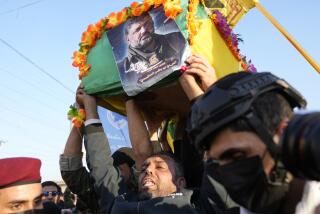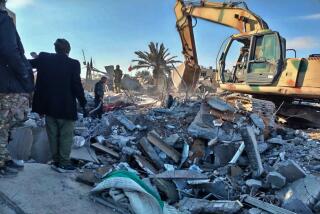Bombing Is Tool of Choice to Clear a Path to Baghdad
- Share via
WASHINGTON — A U.S. decision to engage the Republican Guard with ground troops Monday signals commanders’ confidence that heavy bombing has damaged top-level Iraqi forces so badly that the Americans will soon be able to overcome them and head to Baghdad.
The action illustrates that, despite repeated firefights, sniper attacks and suicide bombings, the campaign is focused on grinding down the four heavy divisions that Saddam Hussein has thrown across a 100-mile perimeter south of the city.
Commanders say air attacks have destroyed more than half of the heavy equipment in the Republican Guard’s Medina Division in the last two days, crossing a threshold that makes a ground attack safer. U.S. forces are racing to hobble the other divisions before reinforcements arrive from north of Baghdad.
On Monday, the 3rd Infantry Division used tanks and artillery to battle elements of the Republican Guard just 50 miles south of Baghdad. The probing ground attacks by American forces were an effort to test the Iraqi defenses, and to gauge how soon U.S. troops can open a full-scale tank attack that they hope will enable them to shatter the enemy line and avoid a bloody battle in the streets of Baghdad.
The U.S. troops “want to make them stand up, so they can pound them,” said Daniel Goure, a former defense official who is with the Lexington Institute research organization.
“It’s a hammer-and-anvil strategy in its most active form.”
The ground offensive may not come Wednesday or even in the next few days, he said. But it is clear that they intend to intensify their strikes on Iraqi forces.
As recently as the middle of last week, Iraqi leadership facilities around Baghdad were U.S. warplanes’ No. 1 target.
Now, two-thirds of the airstrikes -- hundreds of bombs a day -- are against the Republican Guard divisions.
And more and more U.S. forces are reaching the front.
There are now likely more than 90,000 U.S. troops around the capital, probably including some 12,000 from the 101st Airborne Division that have moved southwest of the city since the weekend.
The force of U.S. Marines has also been growing at its front-line positions near Kut, close to the Tigris River and about 100 miles east of the 3rd Infantry Division positions near Karbala.
Commanders are using more and more A-10 Warthogs, the heavily armored fixed-wing planes that can fly low to take out tanks.
Some experts believe they will soon be using heavy bombers, such as the B-52 and B-1, to drop dozens of unguided, or “dumb,” bombs on concentrations of armored forces.
Despite the skirmishes on Monday, most of the engagement between the two sides continues to be at relatively long distances of six to 12 miles.
U.S. troops have moved up artillery and rockets to bombard the Iraqi lines and are using raids with Apache helicopters to knock out tanks, personnel carriers and other heavy equipment.
Last week, Apaches came under intense ground fire when they attacked Republican Guard positions. But this week, a heavy artillery bombardment has apparently forced Iraqi troops to stay under cover, and reduced the risk for the helicopters.
The damage to the Medina Division, which was the best equipped of the Republican Guard units, probably represents a loss of about 150 tanks, 300 armored personnel carriers, 75 artillery pieces and 2,000 light vehicles, analysts said. U.S. officials declined to discuss Iraqi troop casualties, but some experts believe they may have lost several thousand soldiers in the recent bombardment.
U.S. officials say the division has lost about 50% of its equipment. Usually, military units are considered to be out of commission if they have lost 30%.
One senior U.S. military official at Central Command headquarters in Doha, Qatar, said Hussein may be rushing reinforcements from the Guard’s Nebuchadnezzar Division, north of Baghdad, because they have more than enough force there.
But more likely, he said, it was because “things are so bad ... in the south that they decided to bring this very valuable unit south to stiffen the defense.”
Marine Corps Gen. Peter Pace, vice chairman of the Joint Chiefs of Staff, told PBS on Monday night that the Nebuchadnezzar Division was being “badly damaged” as its troops sought to move from the north to southern positions.
There were also signs that the Iraqis had sent some forces from the Adnan Division, which has been assigned to protect the city of Tikrit, home of Hussein and many of the regime’s top leaders. This may be another sign, analysts said, that the Iraqi regime is feeling strain.
U.S. officials and outside experts believe that Hussein has never expected to win an outright military victory. Rather, he hopes to inflict enough casualties -- American and civilian -- and cause enough delay that the United States would be politically unable to continue. With that goal in mind, Hussein has hoped to disperse his troops well enough through the rolling terrain of the Euphrates and Tigris river valleys that they would be difficult to find and destroy.
One military analyst, retired Marine Corps Gen. Bernard Trainor, said he believes the Iraqis will try to set up a “spider web” of hidden, interconnected small units up to 60 miles out from Baghdad. These units would be hard to find, protected by their proximity to civilians, yet able to inflict casualties on U.S. forces if they sought to punch through.
So far, however, the U.S. has apparently had only a handful of casualties from the fighting around Baghdad.
U.S. officials have made it clear that they would like to destroy as much as they can of the Iraqi forces before those forces can withdraw into Baghdad. And even if they try to withdraw with their heavy equipment along the few roads that lead to the city, some analysts maintain that the Iraqis will be easy to spot and destroy.
The guard divisions are apparently in this vulnerable position -- rather than in Baghdad, waiting to confront invading troops there -- because Hussein has not let the Republican Guard into the city for several years for fear of coup attempts.
Once a full-scale ground attack begins, the U.S. goal will be to so thoroughly shatter the Republican Guard divisions that the morale of the forces is destroyed, and Hussein’s other fighting forces, such as the Special Republican Guard and the Special Security Organization, throw down their arms without a fight in the city.
But a senior U.S. official cautioned that Hussein’s military was not the only danger ahead.
“You have to get through the Republican Guard, we’ll call it the outer cordon,” he said. “And then you’ve got ... the inner defense to deal with.”
More to Read
Sign up for Essential California
The most important California stories and recommendations in your inbox every morning.
You may occasionally receive promotional content from the Los Angeles Times.














